Paratrechina
longicornis (Latreille)

 Type location Senegal (Formica
longicornis, Latreille, 1802c:
113, worker; Formica vagans, Jerdon, 1851: 124,
queen, "exceedingly common in the Carnatic"; André, 1881b: 60, male
(from among Egypt, Syria and Palestine); Prenolepis longicornis
Roger, 1863b: 10) Type location Senegal (Formica
longicornis, Latreille, 1802c:
113, worker; Formica vagans, Jerdon, 1851: 124,
queen, "exceedingly common in the Carnatic"; André, 1881b: 60, male
(from among Egypt, Syria and Palestine); Prenolepis longicornis
Roger, 1863b: 10)
junior synonyms
currens (Paratrechina
currens, Motschoulsky, 1863: 14, worker;
synonymy Emery, 1892b: 166) from Russia (wrongly stated as Sri
Lanka by Bolton, 1995: 313) found in hothouses for plants - no
images on Antweb (October 2014)
gracilescens (Formica
gracilescens, n. sp.,
Nylander, 1856a: xxviii, worker; Tapinoma
gracilescens Smith, 1858: 56; synonymy Roger, 1863b: 10, &
Mayr, 1865: 50, as Prenolepis
gracilescens)
from France, in the Jardin-des-Plantes, Paris - no images on
Antweb (October 2014)
vagans
(Formica Vagans N. S.,
Jerdon, 1851: 124, worker & queen; unresolved junior primary
homonym of Formica vagans, Olivier, 1792: 501) from India
- no images on Antweb (October 2014)
all forms described (see Bolton, 1995)  . .
|
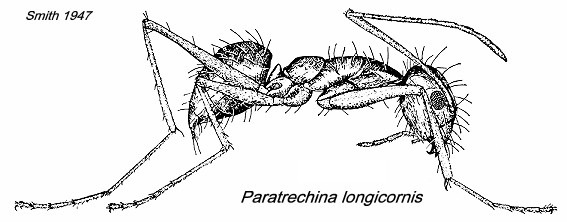 Latreille's
(1802c) description is at Latreille's
(1802c) description is at  ;
Jerdon's (1851) description of the queen is at ;
Jerdon's (1851) description of the queen is at  ; Nylander's (1856a) description of gracilescens
is at ; Nylander's (1856a) description of gracilescens
is at  ; Nylander's (1856b) illustrated note is
at ; Nylander's (1856b) illustrated note is
at  ; Motschoulsky's (1863) note on currens
is
at ; Motschoulsky's (1863) note on currens
is
at  ;
André's (1881b) description
of the male is at ;
André's (1881b) description
of the male is at  ; Forel's (1901h: 605)
description of hagemanni
is at ; Forel's (1901h: 605)
description of hagemanni
is at  ; Emery's (1910a) further description of
specimens from Egypt,
with illustrations, is at ; Emery's (1910a) further description of
specimens from Egypt,
with illustrations, is at  ;
Arnold (1922: 605) referring to specimens from Durban, South Africa,
provided a translation of Latreille's (1802c)
description; this with notes is at ;
Arnold (1922: 605) referring to specimens from Durban, South Africa,
provided a translation of Latreille's (1802c)
description; this with notes is at  and, sexual stages, at
and, sexual stages, at  . The line drawing is from Smith, 1947. . The line drawing is from Smith, 1947.
Roger (1863b: 10) gave the distribution of Prenolepis longicornis Latr., as
Paris; England, Kew; Madeira; Senegal; Guinea; Asien, Ceilon.
Amerika, Chili, Kuba, Mejico.
Motschoulsky's (1863: 13) note on currens follows his description of
the genus Paratrechina and
the species P. vagabunda from
Ceylon (Sri Lanka). He wrote no more than - "a second species a little
smaller, more
slender and of a paler colour on the alitrunk and legs is not uncommon
in our hothouses on plants and I have named it Paratr. currens". The hothouses
were in Russia (probably Moscow, where Motschoulsky lived). P. vagabunda he had given as TL
2.54 mm (1 line = 2.117 mm), HW 0.53 mm, subelongate, dark erect hairs,
piceous, legs femora and tarsi testaceous white.
By comparison Nylander's (1856a: xxviii; and 1856b: 73)
description of gracilescens,
from hothouses in
Paris, gave TL 3 mm. He compared it with Paratrechina vividula (Formica vividula) as noticeably
different by its darker colour, the antennae more elongated, more
slender and the scape without hairs, and lastly by the elongated
alitrunk "uni en dessus", united above, presumably with an even shape,
not waisted at the mesonotum as in the Tapinoma nitens
of Forster and Mayr, 1853 (now Prenolepis
nitens and outside the sciope of this website, but see http://www.formicidae.org/fs-images/results/taxonomy:120.790.791).
Thus, it seems to me the synonymy of currens and longicornis by Emery (1892b: 166)
was a mistake. Emery, in fact, noted the P. currens observed by that author
(Motschoulsky) in the hot houses of Europe seemed to = P. longicornis Latr. Note Emery
wrote “mi pare” and not as he
did for another species, “senza alcun
dubbbio, identica”
(without any doubt). The paler smaller species found in northern
hothouses was most likely to have been Paratrechina vividula,
described by
Nylander (1846a) from hothouses in Helsinki and in Russia (which at
that time included modern Finland).
Note
that the range of specimens that can be seen in the folders linked
from the list of Oxford University Museum specimens varies from quite pale brown to near black with a violet
irridescence.
|
Egypt records - André (1881b: 60, male; 1882b:
203;
plate X); Alfieri (1931) listed 13 findings from Cairo and the
Provinces of Dakahlieh, Fayoum and Assiout. Photographed specimens from
Nagh Shadeed, Aswan, E 32°53' N 24°05'; 8.iii.2003; others from
Shrinkash, Mansurah, E 31°35' N 31°10'; 13.v.2003; collected by Mostafa
Sharaf.
Sharaf list - Material examined: Shrinkash (Daqahliya,
Egypt),
13.v.2003 (19); Talkha (El-Mansoura), 31.vii.2003 (1); Ismailia,
31.xii.1997 (20); Nagh El-Shadeed (Aswan), 8.iii.2003 (1); Damietta,
20.viii.2003 (8); Alag (Qalyubiya), 27.ii.2003 (2); Port Said,
13.xii.1997 (5) (SHC).
|
Oxford University Museum
specimens
Paratrechina longicornis
B Taylor det. |
Egypt
M Sharaf |
8.iii.2003
Aswan
24°05' N
32°53' E
|
Nagh Shadeed |
3
|
 |
Paratrechina longicornis
B Taylor det. |
Egypt
M Sharaf |
13.v.2003
Mansurah
31°10' N
31°35' E
|
Shrinkash
|
1
|
|
|
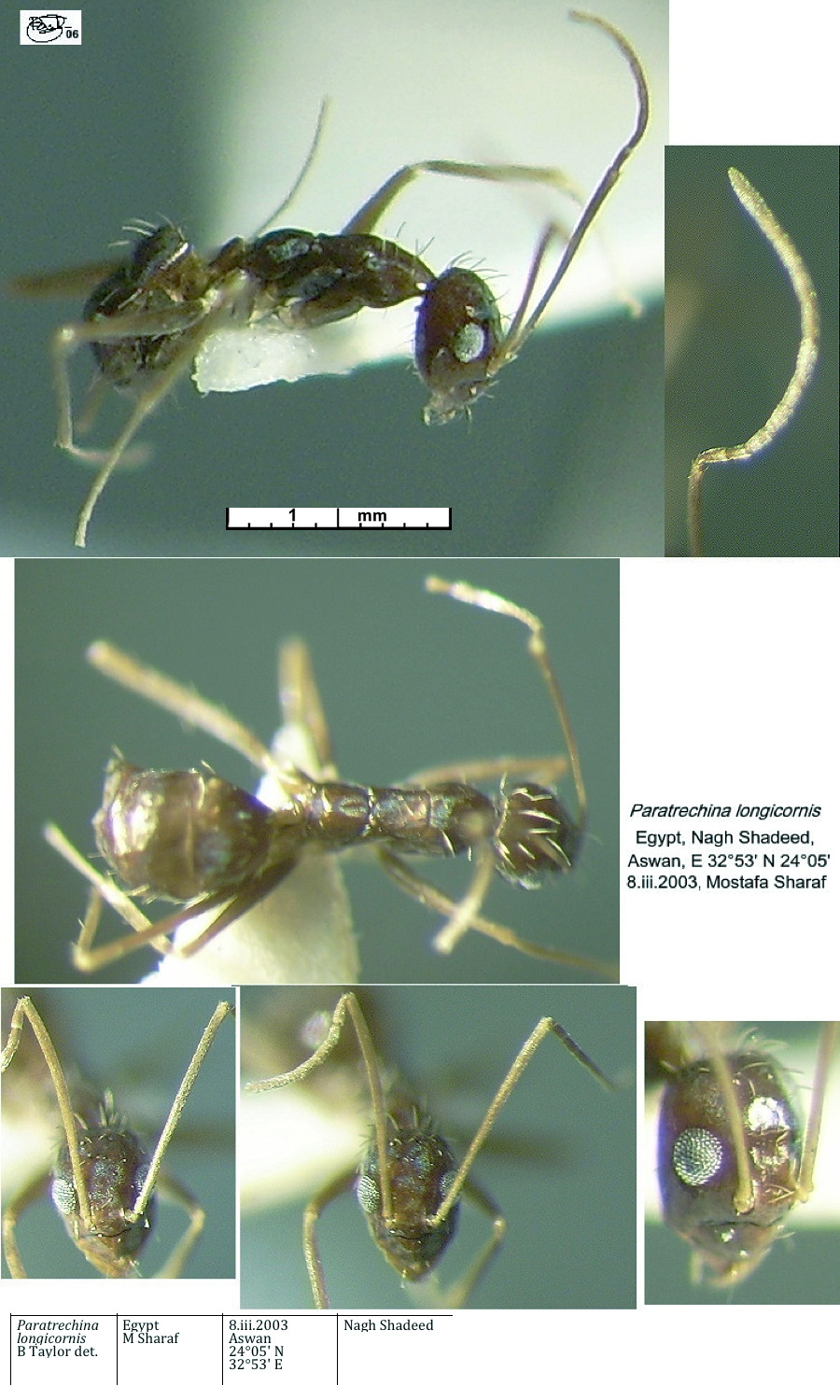 The photomontage is of
a worker from Egypt, Aswan, Nagh Shadeed; collector Mostafa Sharaf. The photomontage is of
a worker from Egypt, Aswan, Nagh Shadeed; collector Mostafa Sharaf.
|
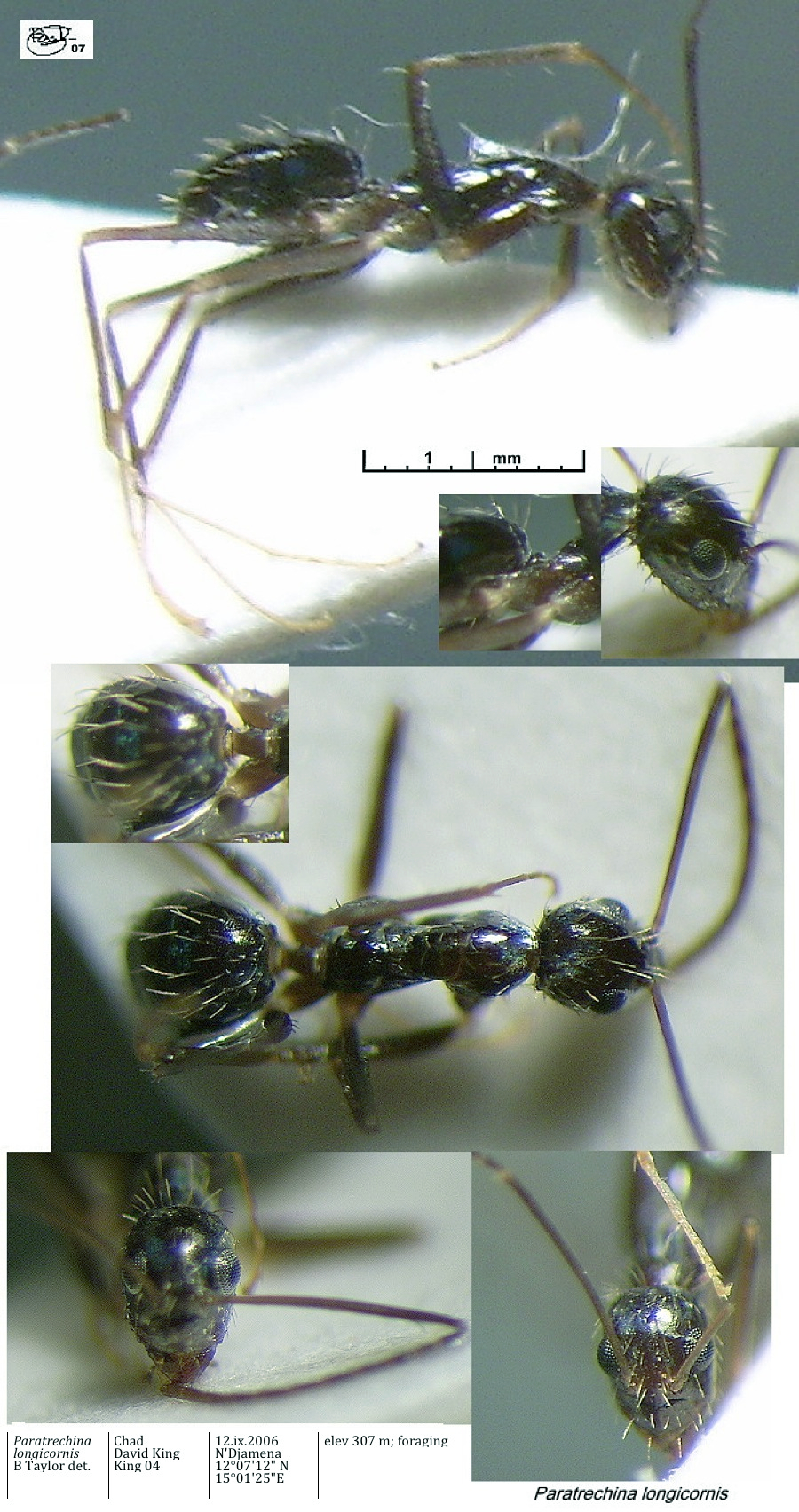 The photomontage is of
a worker from Chad,
N'Djamena; 12°07'12" N 15°01'25" W; 307 m asl; King 36;
collected by David King, 12.ix.2006. The photomontage is of
a worker from Chad,
N'Djamena; 12°07'12" N 15°01'25" W; 307 m asl; King 36;
collected by David King, 12.ix.2006.
|
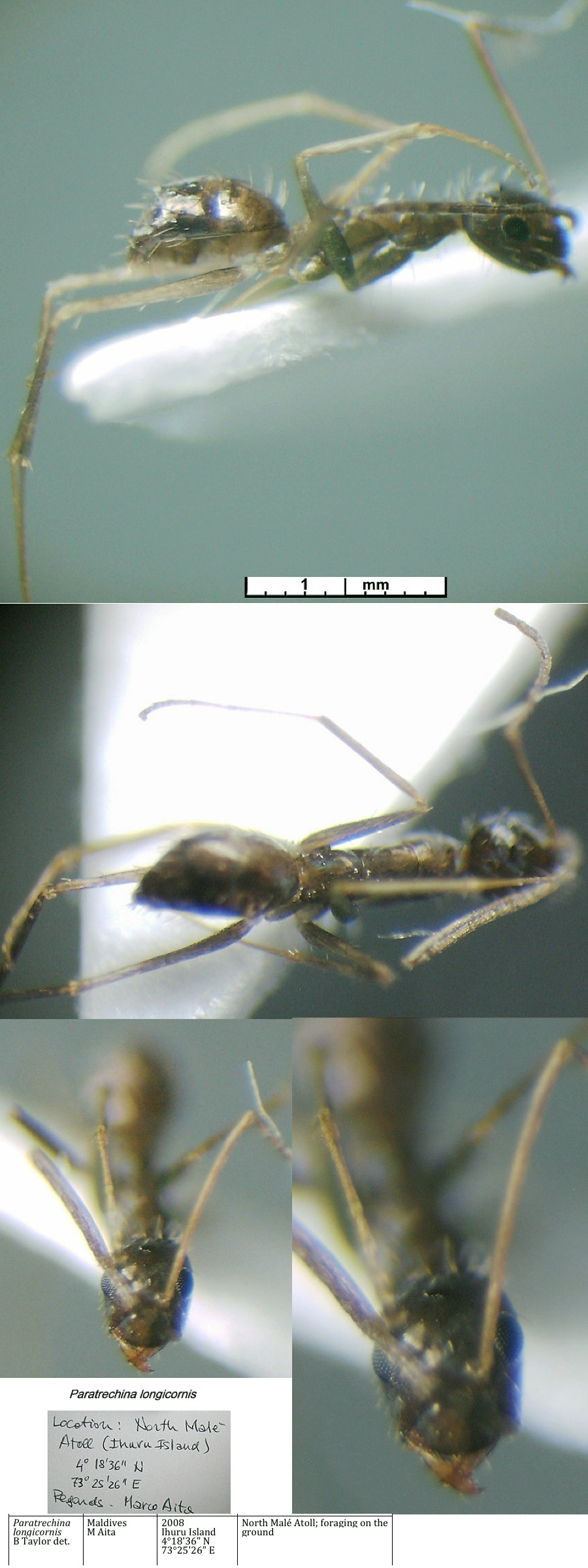 The photomontage is of workers from The Maldives, North Malé
Atoll, Ihuru Island, 4°18'36"N 73°25'26"E, 2008,
collected by Marco Aita. Collected foraging on the ground. The photomontage is of workers from The Maldives, North Malé
Atoll, Ihuru Island, 4°18'36"N 73°25'26"E, 2008,
collected by Marco Aita. Collected foraging on the ground.
|
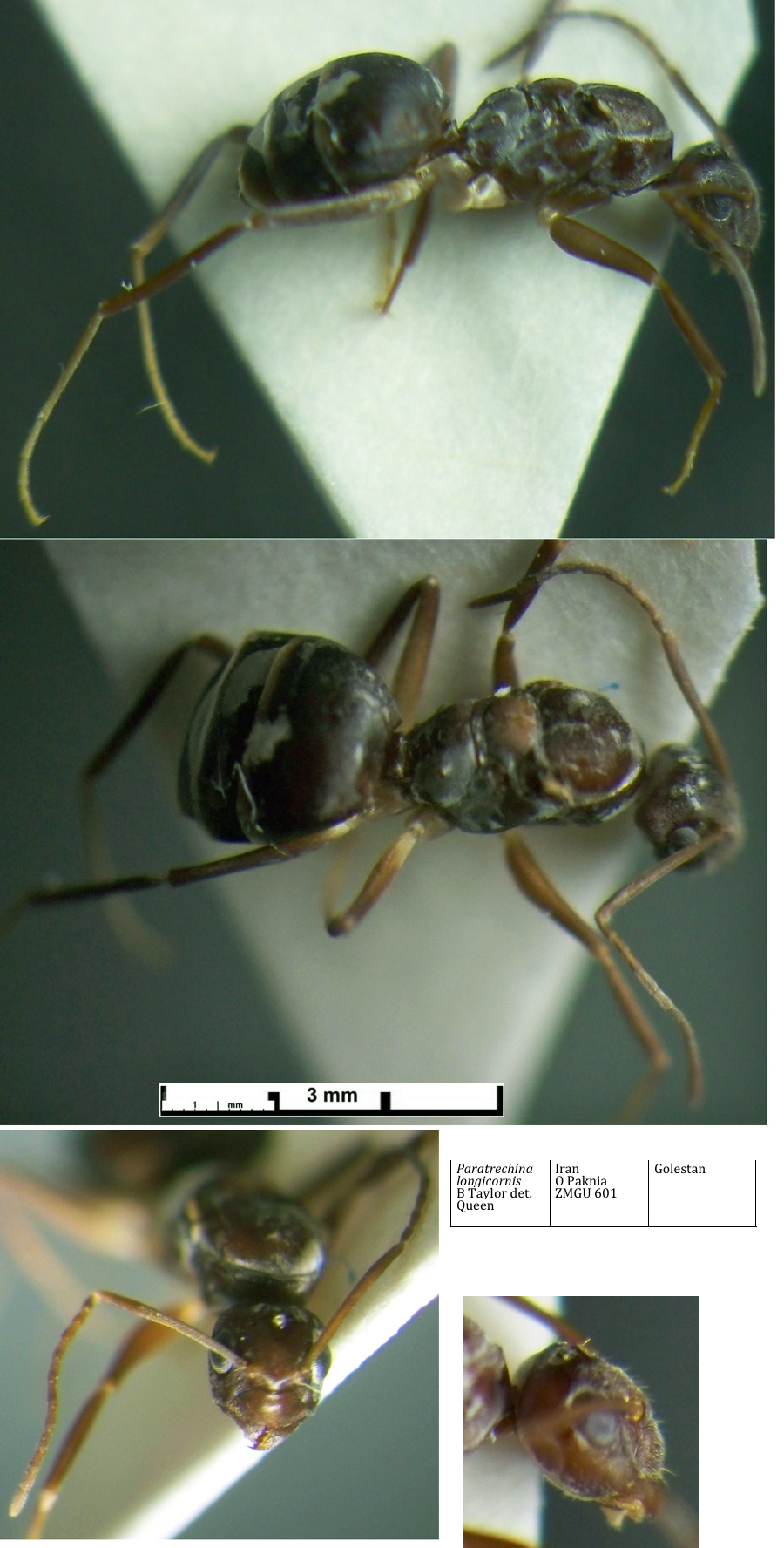 The photomontage
is of a queen
from Iran, collected by Omid Paknia (ZMGU601). The photomontage
is of a queen
from Iran, collected by Omid Paknia (ZMGU601).
|
|